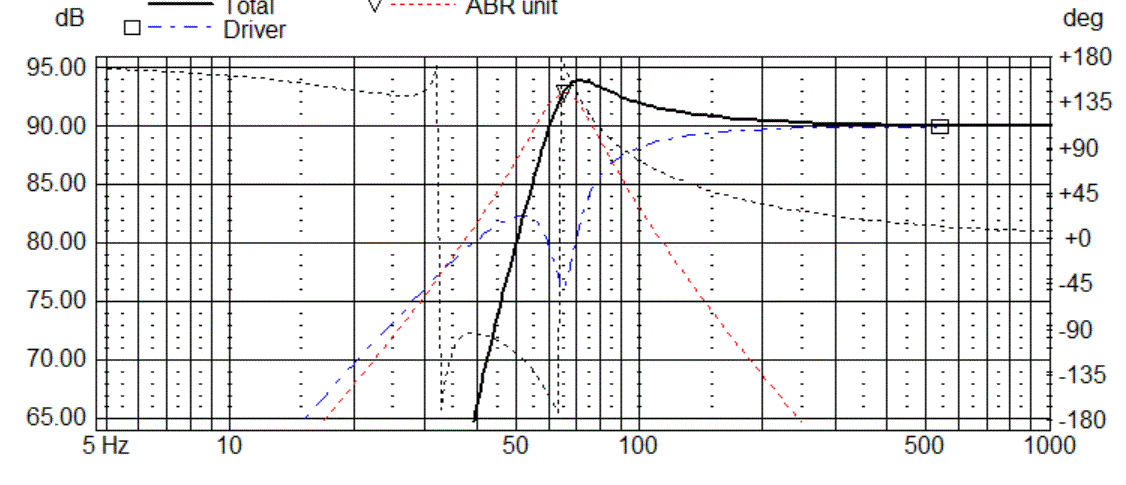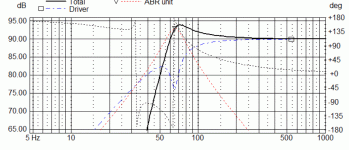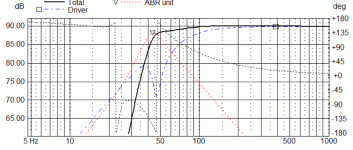A week ago I picked up a faulty KEF KUBE 1 for fun from ebay.
The fault in mine was due to a bad pot, the one that sets the low pass frequency. It had suffered some impact damage that had cracked the little PCB internal to the pot and with it the tracks that the wipers follow. A couple of fixed resistors later and I had a working sub again.
I figured it wouldn't hurt to measure the device and see if there was any room for improvement. Sadly I do not have any FR measurements to hand as these were done quickly but nevertheless the results still stand.
My main point of interest was the frequency that the passive radiator within the thing was tuned to. Measuring the PR with a frequency sweep showed this to be around 67Hz. This made me scratch my head a little We're supposed to be talking about a subwoofer here 67Hz seemed a little too high, especially for an 8" driver. So I then extracted the 8" sub driver and measured its T/S parameters.
We're supposed to be talking about a subwoofer here 67Hz seemed a little too high, especially for an 8" driver. So I then extracted the 8" sub driver and measured its T/S parameters.
Again the results were not quite what I had expected.
Initially I thought that KEF would have gone with a 83-84dB sub driver, with a low fs and low Qts and then tuned low with the PR for an EBS alignment. It turned out that this wasn't exactly true.
Here are the T/S params.
Fs, 59.78, Hz
Re, 3.70, ohms[dc]
Qt, 0.52, -
Qes, 0.57, -
Qms, 5.95, -
Mms, 33.24, grams
Rms, 2.234056, kg/s
Cms, 0.000213, m/N
Vas, 8.15, liters
Sd, 165.13, cm^2
Bl, 9.296382, Tm
Lp(2.83V/1m), 90.42, dB
Le, 741.12, uH
Tiny VAS, middling value Qts, very high estimated sensitivity and a highish value for the drivers fs. Still the tiny vas and middle value Qts would offset one another and the Qts wasn't so high as to make porting/PRing the driver unrealistic.
Simulating with the driver showed that with a PR tuning of around 67Hz resulted in a peaky response with a hump at the tuning frequency.

Not exactly what the doctor ordered but would definitely create a lot of 'thump' from the sub that could otherwise seem impressive but all the while giving hardly any real extension. I expected to get decent output down to 40Hz out of this thing.
Adding mass to a PR lowers the tuning frequency and adding in around 20 grams pushed the tuning frequency from the previous 67Hz down to around 47Hz.

Much better. A nice EBS alignment that would benefit from room gain, lower group delay and give far more extension.
This was of course only in simulation so I got out the precision scales found a nearby solid object that weighed roughly the right amount (an empty printer cartridge 😀) and glued it to the back of the PR with some 3M adhesive goop.
I then measured the tuning frequency and voilà it was pretty much where I expected it to be. Measuring the subs average frequency response, semi near field, with the mic being moved smoothly throughout an arc around the sub, resulted in a nice smooth response without any peaking down low and useful extension down where it really matters.
The sub is now in my workshop filling in the lows of the small speakers that were there already.
So if you own a KEF KUBE 1 you could maybe try giving this a go. To get access to the sub simply remove the plate amplifier by removing the screws around the perimeter of the metal fascia. Do not worry about electrocuting yourself as the plate amp is sealed within its own plastic cup.
If you want to remove the driver you need to unscrew the base of the sub and then prise it away with a large solid flat head screw driver.
The fault in mine was due to a bad pot, the one that sets the low pass frequency. It had suffered some impact damage that had cracked the little PCB internal to the pot and with it the tracks that the wipers follow. A couple of fixed resistors later and I had a working sub again.
I figured it wouldn't hurt to measure the device and see if there was any room for improvement. Sadly I do not have any FR measurements to hand as these were done quickly but nevertheless the results still stand.
My main point of interest was the frequency that the passive radiator within the thing was tuned to. Measuring the PR with a frequency sweep showed this to be around 67Hz. This made me scratch my head a little
 We're supposed to be talking about a subwoofer here 67Hz seemed a little too high, especially for an 8" driver. So I then extracted the 8" sub driver and measured its T/S parameters.
We're supposed to be talking about a subwoofer here 67Hz seemed a little too high, especially for an 8" driver. So I then extracted the 8" sub driver and measured its T/S parameters.Again the results were not quite what I had expected.
Initially I thought that KEF would have gone with a 83-84dB sub driver, with a low fs and low Qts and then tuned low with the PR for an EBS alignment. It turned out that this wasn't exactly true.
Here are the T/S params.
Fs, 59.78, Hz
Re, 3.70, ohms[dc]
Qt, 0.52, -
Qes, 0.57, -
Qms, 5.95, -
Mms, 33.24, grams
Rms, 2.234056, kg/s
Cms, 0.000213, m/N
Vas, 8.15, liters
Sd, 165.13, cm^2
Bl, 9.296382, Tm
Lp(2.83V/1m), 90.42, dB
Le, 741.12, uH
Tiny VAS, middling value Qts, very high estimated sensitivity and a highish value for the drivers fs. Still the tiny vas and middle value Qts would offset one another and the Qts wasn't so high as to make porting/PRing the driver unrealistic.
Simulating with the driver showed that with a PR tuning of around 67Hz resulted in a peaky response with a hump at the tuning frequency.
Not exactly what the doctor ordered but would definitely create a lot of 'thump' from the sub that could otherwise seem impressive but all the while giving hardly any real extension. I expected to get decent output down to 40Hz out of this thing.
Adding mass to a PR lowers the tuning frequency and adding in around 20 grams pushed the tuning frequency from the previous 67Hz down to around 47Hz.
Much better. A nice EBS alignment that would benefit from room gain, lower group delay and give far more extension.
This was of course only in simulation so I got out the precision scales found a nearby solid object that weighed roughly the right amount (an empty printer cartridge 😀) and glued it to the back of the PR with some 3M adhesive goop.
I then measured the tuning frequency and voilà it was pretty much where I expected it to be. Measuring the subs average frequency response, semi near field, with the mic being moved smoothly throughout an arc around the sub, resulted in a nice smooth response without any peaking down low and useful extension down where it really matters.
The sub is now in my workshop filling in the lows of the small speakers that were there already.
So if you own a KEF KUBE 1 you could maybe try giving this a go. To get access to the sub simply remove the plate amplifier by removing the screws around the perimeter of the metal fascia. Do not worry about electrocuting yourself as the plate amp is sealed within its own plastic cup.
If you want to remove the driver you need to unscrew the base of the sub and then prise it away with a large solid flat head screw driver.
Attachments
I would've expected Kef to add a highpass filter to protect from over-excursion below tuning. Was that present in practice? - if so, you might've left a bit of low-end performance on the table.
Chris
Chris
Kef is a company that has some really clever tricks up their sleve, so I think the design is as intended.
I think they've done the same thing that they do with the Kef Reference 107/2. The woofer section is tuned with a bump in the FR to get max efficiency, and then the FR is equalized to the wanted system FR. Then you waste no efficiency in the crossover. This technique, using a Q multiplier is quite common for subs.
Here's the internal EQ curves for the EQ module for the R107/2 (also called a Kube, BTW). The measurement is snagged from Stereophiles test of the 107/2.
Johan-Kr
I think they've done the same thing that they do with the Kef Reference 107/2. The woofer section is tuned with a bump in the FR to get max efficiency, and then the FR is equalized to the wanted system FR. Then you waste no efficiency in the crossover. This technique, using a Q multiplier is quite common for subs.
Here's the internal EQ curves for the EQ module for the R107/2 (also called a Kube, BTW). The measurement is snagged from Stereophiles test of the 107/2.
Johan-Kr
Attachments
Well like I said I measured the subs frequency response before and after the modification too. After the device showed a smooth extended roll off into the bass with a very shallow roll off that would be in part countered by some room gain.
You might be able to increase overall efficiency with a higher tuning and then EQ it flat but this only works over the frequencies centred around the bump. The higher tuning cripples the subs efficiency and output down lower, which is where I want a sub to be at its best. Still the sub showed no signs of complex EQ such as you described otherwise I would have measured it.
A highpass might be present but if so only a very shallow one, if higher in f3, or one that only acts quite low down if it is steeper.
You might be able to increase overall efficiency with a higher tuning and then EQ it flat but this only works over the frequencies centred around the bump. The higher tuning cripples the subs efficiency and output down lower, which is where I want a sub to be at its best. Still the sub showed no signs of complex EQ such as you described otherwise I would have measured it.
A highpass might be present but if so only a very shallow one, if higher in f3, or one that only acts quite low down if it is steeper.
- Status
- Not open for further replies.


